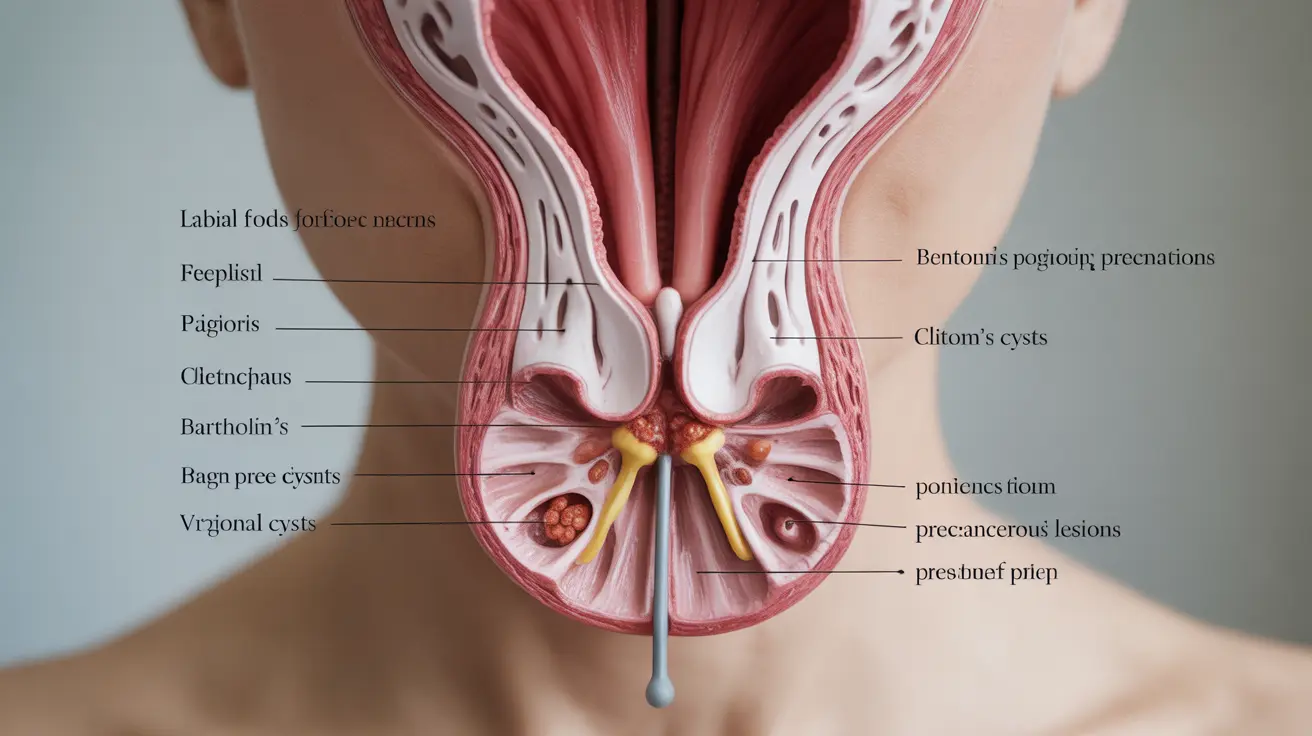Finding a bump on the labia can be concerning, but understanding the potential causes and knowing when to seek medical attention can help ease anxiety. While many labial bumps are harmless, it's important to recognize signs that might indicate a more serious condition requiring medical evaluation.
This comprehensive guide will help you understand the various types of labial bumps, their characteristics, and when you should consult a healthcare provider. We'll also discuss diagnosis, treatment options, and preventive measures to maintain vulvar health.
Common Types of Labial Bumps
Labial bumps can have various causes, ranging from benign to more serious conditions. Understanding these different types can help you better assess your situation:
Benign Causes
Many bumps on the labia are non-cancerous and may resolve on their own:
- Bartholin's cysts
- Sebaceous cysts
- Ingrown hairs
- Folliculitis
- Contact dermatitis
- Skin tags
Potentially Serious Causes
Some bumps may indicate more serious conditions that require medical attention:
- Vulvar cancer
- Precancerous changes (VIN)
- Sexually transmitted infections
- Persistent infections
Signs and Symptoms to Watch For
When evaluating a bump on the labia, pay attention to these characteristics:
Normal Characteristics
- Small, soft bumps
- Flesh-colored or slightly darker
- Smooth surface
- No associated pain
- No changes in size or color
Warning Signs
- Persistent bumps that don't heal
- Changes in color, size, or texture
- Bleeding or unusual discharge
- Itching or burning sensation
- Pain or tenderness
- Hard or firm texture
Diagnosis and Medical Evaluation
Professional evaluation of a labial bump typically involves:
- Physical examination
- Medical history review
- Possible biopsy if concerning features are present
- STI testing when appropriate
- Imaging studies in some cases
Treatment Approaches
Treatment options vary depending on the underlying cause:
Conservative Management
- Warm compresses for cysts
- Proper hygiene practices
- Over-the-counter treatments
- Avoiding irritants
Medical Interventions
- Antibiotics for infections
- Surgical removal when necessary
- Specialized treatments for precancerous or cancerous lesions
- Drainage procedures for large cysts
Prevention and Risk Reduction
To reduce your risk of developing problematic labial bumps:
- Maintain good hygiene
- Wear breathable, cotton underwear
- Avoid harsh soaps and irritants
- Practice safe sex
- Get regular gynecological check-ups
- Stay up-to-date with HPV vaccination
- Quit smoking if applicable
Frequently Asked Questions
- What does a cancerous bump on the labia look like, and how can I tell if it's serious?
A potentially cancerous bump on the labia often appears as a persistent, firm lump that may be white, pink, or darker in color. Warning signs include changes in size or color, bleeding, persistent itching, or pain. Any bump that doesn't heal within a few weeks should be evaluated by a healthcare provider.
- Should I be worried about a lump on my labia if it's not painful or bleeding?
While absence of pain or bleeding is reassuring, it doesn't guarantee the bump is benign. Monitor for changes in size, color, or texture. If the bump persists for more than a few weeks or you notice any changes, consult a healthcare provider for evaluation.
- How is a bump on the labia diagnosed, and what kind of doctor should I see for this?
A gynecologist or primary care physician can evaluate labial bumps through physical examination and medical history review. They may perform additional tests like biopsies or cultures if needed. Start with your regular healthcare provider, who can refer you to a specialist if necessary.
- What are the treatment options if a bump on the labia turns out to be vulvar cancer?
Treatment for vulvar cancer typically involves surgery to remove the affected tissue. Additional treatments may include radiation therapy and/or chemotherapy, depending on the stage and extent of the cancer. A gynecologic oncologist will develop a personalized treatment plan.
- How can I lower my risk of developing vulvar cancer or other serious causes of a bump on the labia?
Reduce your risk by getting regular gynecological check-ups, maintaining good hygiene, getting HPV vaccination if eligible, practicing safe sex, avoiding tobacco use, and promptly addressing any unusual symptoms or changes in the vulvar area.




